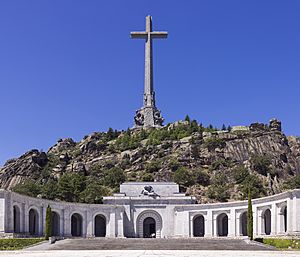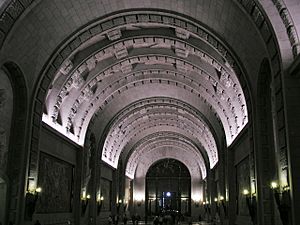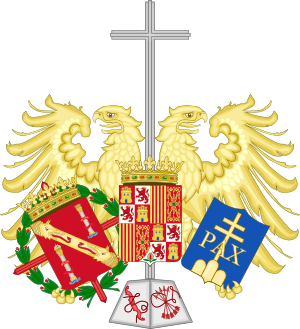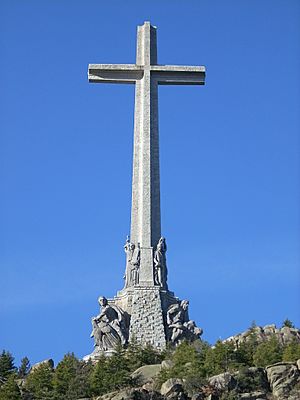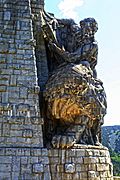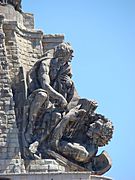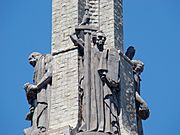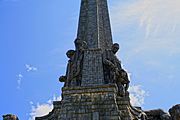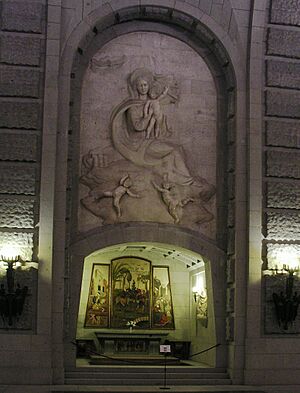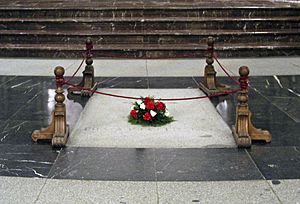Valley of the Fallen facts for kids
The Valley of Cuelgamuros (which means Valley of Cuelgamuros in Spanish), was known as the Valley of the Fallen until 2022. It is a special memorial site in Spain, located in the Sierra de Guadarrama mountains. This place was built to remember everyone who lost their lives during the Spanish Civil War. It is near the town of San Lorenzo de El Escorial, not far from Madrid.
The memorial was ordered by the Spanish leader Francisco Franco in 1940. It took many years to build, finally opening to the public in 1959. Franco said the monument was meant to be a way for the country to heal and come together. From 1975 until 2019, Franco was buried here. However, after a long process, his remains were moved on October 24, 2019, because the government wanted to remove public symbols of his rule.
The monument is a famous example of 20th-century Spanish architecture. It was designed to be very grand, like ancient monuments that last forever. It has a unique Spanish style, often used for public buildings after the war.
The whole area covers more than 3,360 square kilometers (1,300 square miles) of forests and rocky hills in the Sierra de Guadarrama. It sits high up, over 900 meters (3,000 feet) above sea level. The site includes a large church called a basilica, a Benedictine monastery, a guest house, and four old stone pillars from the 1500s. The most striking part is the huge Christian cross, which is 150 meters (490 feet) tall. It's the tallest cross in the world and can be seen from over 30 kilometers (19 miles) away! The construction started in 1940 and took 18 years. It officially opened on April 1, 1959. Building it cost a lot of money, which came from national lottery games and donations. Some of the workers were prisoners who got their sentences reduced for their labor.
The Spanish government agency, Patrimonio Nacional, owns and manages the complex. It was one of the most visited monuments in Spain in 2009. The government closed it to visitors at the end of 2009, saying it was for safety and repairs. This decision caused some debate, as some people believed it was related to a new law about historical memory.
Contents
The Basilica, Cross, and Abbey
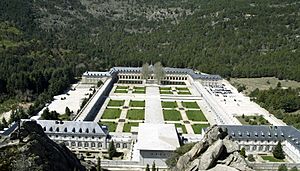
One of the world's largest basilicas stands in the valley, along with the tallest memorial cross. The Basilica of the Holy Cross of the Valley of the Fallen is carved right into a granite mountain. The 150-meter (490-foot) tall cross is made of stone. In 1960, Pope John XXIII declared the underground crypt a basilica. This underground basilica is actually larger than St. Peter's Basilica in Rome. To avoid competing with the famous church in the Vatican City, a wall was built inside, and a large entrance area was left unconsecrated. The sculptures inside the basilica, honoring those who died, were created by Spanish artist Luis Sanguino.
The huge sculptures above the main gate and at the base of the cross were the final works of Juan de Ávalos. The monument has a wide open area called an explanada (esplanade) with views of the valley and Madrid in the distance. A long, arched crypt was tunneled through solid granite, going deep into the mountain to a massive central area directly under the cross.
On the iron gates, you can see Franco's double-headed eagle symbol. Inside the basilica, visitors see two large metal statues of angels holding swords. There used to be a funicular (a type of cable car) that connected the basilica to the base of the cross. There's also a spiral staircase and a lift inside the cross, but only maintenance staff can use them. The Benedictine Abbey of the Holy Cross of the Valley of the Fallen is on the other side of the mountain. Priests there hold daily Masses to remember those who died in the Spanish Civil War and other conflicts. This abbey is considered a Royal Monastery.
The Valley of Cuelgamuros
The valley where the monument is located is a national park. It's about 10 kilometers (6 miles) northeast of the royal site of El Escorial, northwest of Madrid. Underneath the valley floor, there are the remains of about 40,000 people. Their names are listed in the monument's records. The valley holds graves of both sides from the Spanish Civil War. However, the words carved in stone say Caídos por Dios y por España (Fallen for God and for Spain), which was a motto of Franco's government. Many people from the Republican side were buried here without their families' permission or even knowledge. Some estimates say there are 33,800 victims of Franco's rule buried here, and their families have faced legal challenges trying to get their loved ones' remains back. Franco's body was moved from the church in 2019 to discourage public worship at the site.
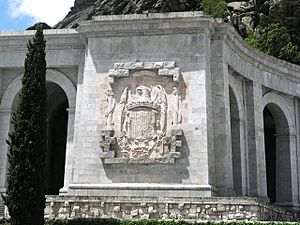
Franco's Burial (1975–2019)
After Francisco Franco died in 1975, the temporary government decided to bury him at this site. Franco's family said they didn't have a preference for where he should be buried. The decision was likely made by the king at the time. The family agreed to the government's request to bury him in the Valley.
Before his death, no one expected Franco to be buried there. His grave had to be dug and prepared very quickly, causing last-minute changes to the basilica's plumbing. Unlike the Civil War victims, who were buried in tombs on the sides of the basilica, Franco was buried behind the main altar in the central part of the church. His grave was marked only with his first and last name. Franco was the only person buried in the Valley who did not die in the Civil War. Some people argued that as the person who promoted the basilica's construction, he could be buried there, according to Catholic Church rules.
Franco was the second person buried in the Santa Cruz basilica. He had previously arranged for José Antonio Primo de Rivera, the founder of the Falange movement, to be buried there. Primo de Rivera was executed in 1936 and was buried under a simple gravestone on the other side of the altar. He died on November 20, 1936, exactly 39 years before Franco. Because of this, November 20 is a day when many of Franco's supporters and related groups gather at the site for memorial services.
Moving Franco's Remains
In 2011, a group of experts suggested that Franco's remains should be moved from the Valley. They believed the Valley should only be for those who died in the Civil War. They also suggested that Primo de Rivera's remains should stay but be moved to be equal with other Civil War victims. This decision needed the Catholic Church's permission because it was inside a basilica. Some members of the expert group disagreed, saying moving Franco's remains would cause more division in Spain.
On March 15, 2019, the government announced that Franco would be moved and reburied at Mingorrubio Cemetery with his wife, Carmen Polo. On September 24, 2019, the Supreme Court agreed with the exhumation.
On October 24, 2019, Franco's coffin was removed from the basilica in the Valley of the Fallen. His family carried the coffin out, with some shouting "Long live Spain! Long live Franco!" as it was put into a hearse. It was then flown by helicopter to the Mingorrubio-El Pardo municipal cemetery, where Franco was reburied next to his wife.
Monument Closure and Reopening
In November 2009, the government agency Patrimonio Nacional closed the basilica for an unknown period, saying there were problems with the Cross and some sculptures. Some experts and the Benedictine monks living there disagreed with this reason. Some conservative groups saw it as an attack on the monument. In 2010, work began on a sculpture called the Pietà, using heavy tools. Some people worried this would damage the artwork.
After the 2011 general election, the government reopened the monument to the public on June 1, 2012. Only the base of the cross remained closed for repairs. Before the official reopening, people could already access the basilica in 2011. Starting June 1, 2012, the entry fee was 5 euros. This fee was expected to bring in about 2 million euros a year if the Valley of the Fallen attracted 500,000 visitors annually again, which was the number before it closed in 2009. On May 2, 2013, the entry fee was increased to 9 euros. Before its closure in 2009, the Valley of the Fallen was the third most visited site managed by Patrimonio Nacional, after the Royal Palace of Madrid and El Escorial. A cafeteria and restaurant were also reopened for visitors. The Valley of the Fallen had 254,059 visitors in 2015, 262,860 in 2016, 283,263 in 2017, 378,875 in 2018, and 318,248 in 2019.
See also
 In Spanish: Valle de los Caídos para niños
In Spanish: Valle de los Caídos para niños
- Fascism in Spain
- Imperial Route of the Community of Madrid


